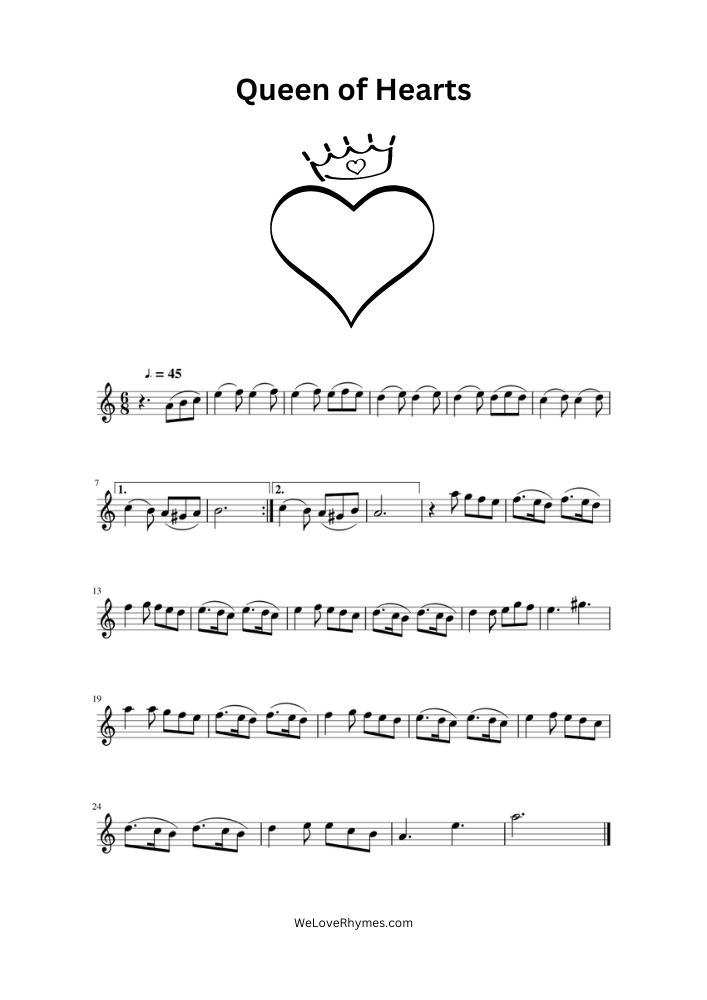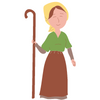The Queen of Hearts is a poem and nursery rhyme with a very interesting history.
According to the Baring-Goulds in The Annotated Mother Goose, “The Queen of Hearts” nursery rhyme first appeared in print in 1782, in the European Magazine. This source and the Opies in The Oxford Dictionary of Nursery Rhymes concur that there were three other stanzas that were not used in children’s books. The text is somewhat bawdier and was perhaps deemed inappropriate for children.
In 1805 Charles Lamb published his first nursery book, entitled King and Queen of Hearts: with the Rogueries of the Knave who stole the Queen’s Pies. According to the Opies, Halliwell included the rhyme in his 1844 edition and then dropped it. It also appeared in the Caldecott edition of 1881. The rhyme did not appear in many early editions but appears to have gotten a boost in popularity after Lewis Carroll worked it into his novel, Alice’s Adventures in Wonderland.
A great deal of controversy swirls around who the Queen in The Queen of Hearts rhyme actually was. Since some nursery rhymes evolved out of political satire directed at the ruling monarch’s, should we assume that here? Or, since this rhyme is often associated with playing cards, should we look to the history of cards to determine who she was? Does it even matter?
Thomas, in Real Personage of Mother Goose, claims she was Elizabeth, titular Queen of Bohemia, granddaughter of Mary Queen of Scots. However, the basis for this judgment is disputed. Scholars of John Tenniel’s Alice illustrations, playing card historians, and Personage author Thomas all disagree with one another. Benham, in his classic book, Playing Cards: History of the Pack and Explanations of its Many Secrets, notes that early French decks portrayed the Queen of Hearts as Judith from the Bible. This card, from 1650, even labels her as “Judic” or Judith.
Benham explains that the story of Judith killing the Assyrian General, Holofernes, and thus saving Israel, showed her to be a woman of great courage, and her Heart meant Courage to the French. There was an actual French queen, Judith of Bavaria, but apparently, she was not well-liked enough to have been chosen for the card. It is doubtful that the Queen in our nursery rhyme had any relationship to the biblical Judith. English playing cards, which developed after the French decks, based their illustrations closely on the French decks, and not on any particular English monarchs.
Which came first, playing cards or the rhyme? Most definitely, playing cards. French decks with illustrations of kings and queens existed as early as 1650; the rhyme first appears in print in 1782. So, if one assumes that the cards inspired the rhyme, it seems unlikely that our Queen was based on any actual queen from history. However, there is still far more research that could be done on this question. At the very least, we can agree that The Queen of Hearts has come to represent many queens in history. The Queen in the Alice illustrations, however, is another story. See the Alice Connection.
There is a strong possibility, however, that the Knave of Hearts is a real person from history. Here, the connection between playing card history and the rhyme’s history do collide. According to Benham, the French Knave of Hearts card was based on an actual personality, who was a prankster much like the Knave of Hearts in our rhyme. His name was Etienne de Vignoles, but he went by the nickname, La Hire (meaning, the growling of dogs).
He was born in 1390 in Gascony and died in 1443. Numerous stories were told of his exploits as a mercenary, gambler, and pillager; he was sometimes depicted as the French equivalent of Robin Hood, but more vicious. As to the nursery rhyme, Benham states:
“The old nursery rhyme about the Knave of Hearts who stole the tarts and was beaten for so doing by the King seems to be founded on nothing more than the fact that ‘hearts’ rhymes with ‘tarts.’
Still, it may be mentioned that in France La Hire was also a favorite subject for jocular nonsense rhymes, sometimes hinting at his pillaging propensities. As an example take some old verses by martial d’Auvergne, describing a visit by La Hire and Python de Xaintrailles to Charles VII:
Un jour que La Hire et Poton
Le vindrent voir, pour festoiement
N’avoit qu’une queue de mouton
Et deux poullets tant seulement.
(One day when La Hire and Poton came to see Charles VII, by way of entertainment he had nothing but a sheep’s tail and a couple of chickens.)”
This was the closest evidence found that the rhyme is based on an incident from history.
The Queen of Hearts Lyrics
The Queen of Hearts,
She made some tarts,
All on a summer’s day:
The Knave of Hearts,
He stole the tarts,
And took them clean away.
The King of Hearts,
Call’d for the tarts,
And beat the knave full sore:
The Knave of Hearts
Brought back the tarts,
And vow’d he’d steal no more.
Queen of Hearts Music Sheet




